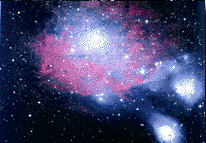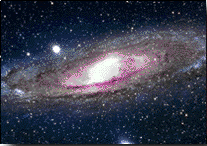
When we look at the night sky we see the Milky Way when we look along the plane of this disk whereas when we look in other directions
Visible light we cannot see the center of the galaxy.
The Milky Way System
On a dark night we can often see a band of light stretching across the sky. If we look at this band with binoculars or a small telescope we see that it is partially resolved into stars. This band we call the Milky Way and indeed it is composed of a band of stars most of which are too faint to be resolved so that we see their combined light as a faint glow.
This band is the plane of the disk of our galaxy. The Sun is one, rather faint, example of approximately 200,000,000,000 stars that make up our galaxy. These stars are mostly grouped into a flattened disk which has a bulge at its centre. The Sun is in this disk about two thirds of the way from its centre to its edge. When we look at the night sky we see the Milky Way when we look along the plane of this disk whereas when we look in other directions, out of the plane, we see far fewer stars.
There is a spherical component to our galaxy which contains very old stars and spherical clusters of old stars. These are often referred to as Population 2 objects. Population 1 being the objects found in the disk. The size of our galaxy is huge; light would take about 100,000 years to cross the Galaxy.
The adjacent figure shows a telescopic view of the Milky Way in the constellation Scorpius. The center of the galaxy is in the left middle of this figure, but it is obscured by the gas and dust lying between us and the center (the dark bands in the figure).
Thus, in visible light we cannot see the center of the galaxy. However, visible light is not the only wavelength at which modern astronomers can make observations.
